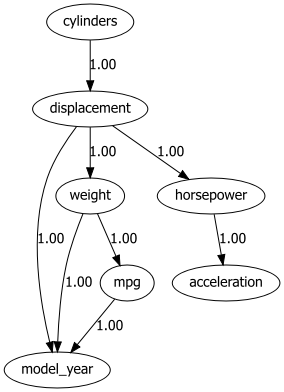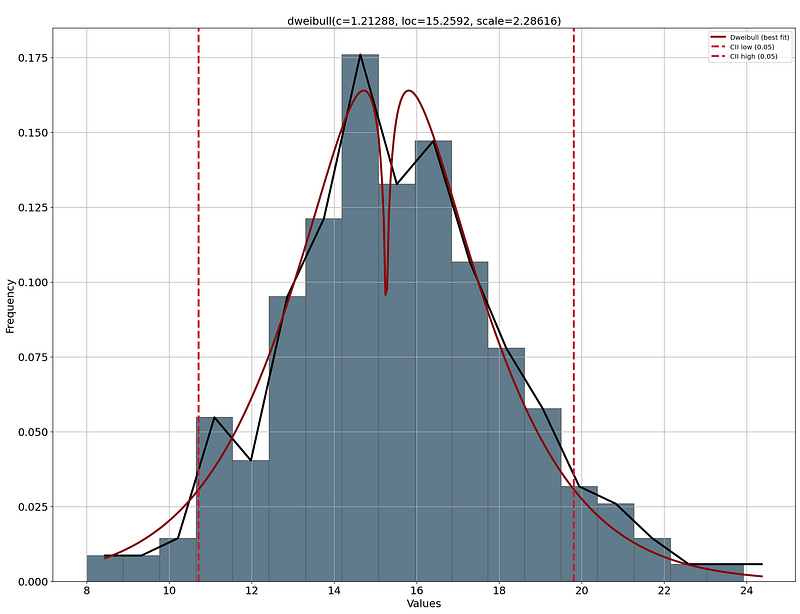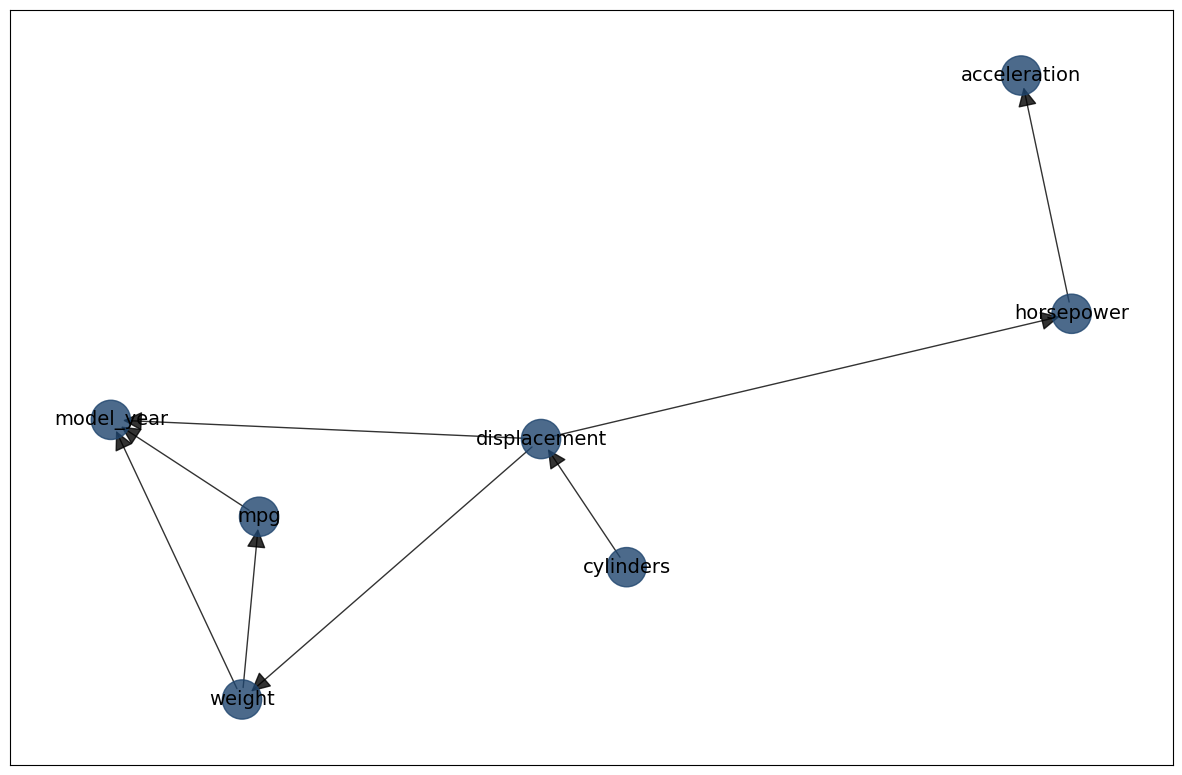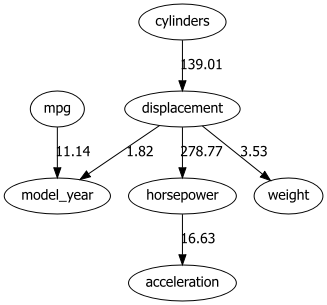Discretizing
In bnlearn, the following options are available to work with continuous datasets:
Discretize continuous datasets manually using domain knowledge
Discretize continuous datasets using probability density fitting
Discretize continuous datasets using a principled Bayesian discretization method
Model continuous and hybrid datasets in a semi-parametric approach that assumes linear relationships
Manual Discretization
Discretizing continuous datasets manually using domain knowledge involves dividing a continuous variable into a set of discrete intervals based on an understanding of the data’s context and the relationships between variables. This method allows for meaningful groupings of data points, which can simplify analysis and improve interpretability in models.
By leveraging expertise in the subject matter, the intervals or thresholds can be chosen to reflect real-world significance, such as categorizing weather conditions into meaningful ranges (e.g., “freezing,” “warm,” “hot”). This approach contrasts with automatic binning methods (as depicted in approach 2), such as equal-width or equal-frequency binning, where intervals may not correspond to meaningful domain-specific boundaries.
For instance, let’s load the auto mpg dataset and, based on automotive standards, define horsepower categories:
Low: Cars with horsepower less than 100 (typically small, fuel-efficient cars)
Medium: Cars with horsepower between 100 and 150 (moderate performance cars)
High: Cars with horsepower above 150 (high-performance vehicles)
After all continuous variables are categorized, the normal structure learning procedure can be applied.
# Import libraries
import bnlearn as bn
import pandas as pd
# Load dataset
df = bn.import_example(data='auto_mpg')
# Print dataset overview
print(df)
# mpg cylinders displacement ... acceleration model_year origin
# 0 18.0 8 307.0 ... 12.0 70 1
# 1 15.0 8 350.0 ... 11.5 70 1
# 2 18.0 8 318.0 ... 11.0 70 1
# 3 16.0 8 304.0 ... 12.0 70 1
# 4 17.0 8 302.0 ... 10.5 70 1
# .. ... ... ... ... ... ... ...
# 387 27.0 4 140.0 ... 15.6 82 1
# 388 44.0 4 97.0 ... 24.6 82 2
# 389 32.0 4 135.0 ... 11.6 82 1
# 390 28.0 4 120.0 ... 18.6 82 1
# 391 31.0 4 119.0 ... 19.4 82 1
#
# [392 rows x 8 columns]
# Define horsepower bins based on domain knowledge
bins = [0, 100, 150, df['horsepower'].max()]
labels = ['low', 'medium', 'high']
# Discretize horsepower using the defined bins
df['horsepower_category'] = pd.cut(df['horsepower'], bins=bins, labels=labels, include_lowest=True)
# Print the results
print(df[['horsepower', 'horsepower_category']].head())
# horsepower horsepower_category
# 0 130.0 medium
# 1 165.0 high
# 2 150.0 medium
# 3 150.0 medium
# 4 140.0 medium
Automatic Discretization: Probability Density
In contrast to manual discretization, we can also automatically determine the best binning per variable. However, such approaches require extra attention compared to manual binning methods, where intervals may not correspond to meaningful domain-specific boundaries. To automatically create more meaningful bins than simple equal-width or equal-frequency binning, we can determine the distribution that best fits the signal and then use the 95% confidence interval to create low, medium, and high categories.
It is always wise to have a visual inspection of the distribution plots with the thresholds determined for the binning. This way, you can decide whether the low-end, medium, and high-end thresholds are meaningful. For example, if we take acceleration and perform this approach, we find a low-end of 8 seconds to ~11 seconds which represents the fast cars. On the high end are the slow cars with an acceleration of 20 seconds to 24 seconds. The remaining cars fall in the category “normal.” This seems very plausible, so we can continue with these categories. See the code block below.
# Import required libraries
from distfit import distfit
import matplotlib.pyplot as plt
# Initialize and set 95% confidence interval
dist = distfit(alpha=0.05)
# Fit and transform the data
dist.fit_transform(df['acceleration'])
# Create visualization
dist.plot()
plt.show()
# Define bins based on distribution
bins = [df['acceleration'].min(),
dist.model['CII_min_alpha'],
dist.model['CII_max_alpha'],
df['acceleration'].max()]
# Discretize acceleration using the defined bins
df['acceleration_category'] = pd.cut(df['acceleration'],
bins=bins,
labels=['fast', 'normal', 'slow'],
include_lowest=True)
del df['acceleration']
|
For multiple continuous variables, we can automate the distribution fitting:
# Process all remaining columns
cols = ['mpg', 'displacement', 'weight']
# Apply distribution fitting to each variable
for col in cols:
# Initialize and set 95% confidence interval
dist = distfit(alpha=0.05)
dist.fit_transform(df[col])
# Create visualization
dist.plot()
plt.show()
# Define bins based on distribution
bins = [df[col].min(),
dist.model['CII_min_alpha'],
dist.model['CII_max_alpha'],
df[col].max()]
# Discretize using the defined bins
df[col + '_category'] = pd.cut(df[col],
bins=bins,
labels=['low', 'medium', 'high'],
include_lowest=True)
del df[col]
After all continuous variables are categorized, the causal discovery approach for structure learning can be applied.
# Perform structure learning
model = bn.structure_learning.fit(df, methodtype='hc')
# Compute edge strength
model = bn.independence_test(model, df)
# Create visualizations
bn.plot(model, edge_labels='pvalue')
dotgraph = bn.plot_graphviz(model, edge_labels='pvalue')
dotgraph
|
Automatic Discretization: Principled Bayesian
Automatic discretization of datasets can be accomplished using a principled Bayesian discretization method. This method was created by Yi-Chun Chen et al. [1] in Julia [2]. The code has been ported to Python and is now part of bnlearn. Yi-Chun Chen demonstrates that this proposed method is superior to the established minimum description length algorithm.
A limitation of this approach is that you need to pre-define the edges before applying the discretization method. The underlying idea is that after applying this discretization method, structure learning approaches can then be applied. To demonstrate the usage of automatic discretization for continuous data, let’s use the auto mpg dataset again.
# Import libraries
import bnlearn as bn
# Load dataset
df = bn.import_example(data='auto_mpg')
# Print dataset overview
print(df)
# mpg cylinders displacement ... acceleration model_year origin
# 0 18.0 8 307.0 ... 12.0 70 1
# 1 15.0 8 350.0 ... 11.5 70 1
# 2 18.0 8 318.0 ... 11.0 70 1
# 3 16.0 8 304.0 ... 12.0 70 1
# 4 17.0 8 302.0 ... 10.5 70 1
# .. ... ... ... ... ... ... ...
# 387 27.0 4 140.0 ... 15.6 82 1
# 388 44.0 4 97.0 ... 24.6 82 2
# 389 32.0 4 135.0 ... 11.6 82 1
# 390 28.0 4 120.0 ... 18.6 82 1
# 391 31.0 4 119.0 ... 19.4 82 1
#
# [392 rows x 8 columns]
# Define the edges
edges = [
("cylinders", "displacement"),
("displacement", "model_year"),
("displacement", "weight"),
("displacement", "horsepower"),
("weight", "model_year"),
("weight", "mpg"),
("horsepower", "acceleration"),
("mpg", "model_year"),
]
# Create DAG based on edges
DAG = bn.make_DAG(edges)
# Create visualizations
bn.plot(DAG)
bn.plot_graphviz(DAG)

We can now discretize the continuous columns as follows:
# Set continuous columns as float
continuous_columns = ["mpg", "displacement", "horsepower", "weight", "acceleration"]
# Discretize the continuous columns
df_discrete = bn.discretize(df, edges, continuous_columns, max_iterations=1)
# Print results
print(df_discrete)
# mpg cylinders ... model_year origin
# 0 (17.65, 21.3] 8 ... 70 1
# 1 (8.624, 15.25] 8 ... 70 1
# 2 (17.65, 21.3] 8 ... 70 1
# 3 (15.25, 17.65] 8 ... 70 1
# 4 (15.25, 17.65] 8 ... 70 1
# .. ... ... ... ... ...
# 387 (25.65, 28.9] 4 ... 82 1
# 388 (28.9, 46.6] 4 ... 82 2
# 389 (28.9, 46.6] 4 ... 82 1
# 390 (25.65, 28.9] 4 ... 82 1
# 391 (28.9, 46.6] 4 ... 82 1
#
# [392 rows x 8 columns]
At this point, the dataset is no different from any other discrete dataset. We can specify the DAG together with the discrete dataframe and fit a model using bnlearn.
Structure Learning
We will learn the structure on the discretized continuous data. Note that the data is also discretized on a set of edges, which may introduce a bias in the learned structure.
# Learn the structure
model = bn.structure_learning.fit(df_discrete, methodtype='hc', scoretype='bic')
# Perform independence test
model = bn.independence_test(model, df, prune=True)
# [bnlearn] >Compute edge strength with [chi_square]
# [bnlearn] >Edge [weight <-> mpg] [P=0.999112] is excluded because it was not significant (P<0.05) with [chi_square]
# Create visualizations
bn.plot(model, edge_labels='pvalue')
bn.plot_graphviz(model, edge_labels='pvalue')
bn.plot(model, interactive=True)
|
|
Parameter Learning
Let’s continue with parameter learning on the continuous dataset and see whether we can estimate the CPDs.
# Fit model based on DAG and discretized continuous columns
model = bn.parameter_learning.fit(DAG, df_discrete)
# Alternative: Use MLE method
# model_mle = bn.parameter_learning.fit(DAG, df_discrete, methodtype="maximumlikelihood")
After fitting the model on the DAG and dataframe, we can perform the independence test to remove any spurious edges and create a plot. In this case, the tooltips will contain the CPDs as these are computed with parameter learning.
# Perform independence test
model = bn.independence_test(model, df, prune=True)
# Create visualizations
bn.plot(model, edge_labels='pvalue')
bn.plot_graphviz(model, edge_labels='pvalue')
bn.plot(model, interactive=True)
|
|
There are various ways to investigate the results further, such as examining the CPDs.
# Print CPDs
print(model["model"].get_cpds("mpg"))
weight |
… |
weight((3657.5, 5140.0]) |
mpg((8.624, 15.25]) |
… |
0.29931972789115646 |
mpg((15.25, 17.65]) |
… |
0.19727891156462582 |
mpg((17.65, 21.3]) |
… |
0.13313896987366375 |
mpg((21.3, 25.65]) |
… |
0.12439261418853255 |
mpg((25.65, 28.9]) |
… |
0.12439261418853255 |
mpg((28.9, 46.6]) |
… |
0.12147716229348882 |
# Print weight categories
print("Weight categories: ", df_disc["weight"].dtype.categories)
# Weight categories: IntervalIndex([(1577.73, 2217.0], (2217.0, 2959.5], (2959.5, 3657.5], (3657.5, 5140.0]], dtype='interval[float64, right]')
Making Inferences
Making inferences can be performed using the fitted model. Note that the evidence should be discretized, for which we can use the discretize_value function.
# Discretize evidence
evidence = {"weight": bn.discretize_value(df_discrete["weight"], 3000.0)}
print(evidence)
# {'weight': Interval(2959.5, 3657.5, closed='right')}
# Perform inference
print(bn.inference.fit(model, variables=["mpg"], evidence=evidence, verbose=0))
mpg |
phi(mpg) |
|---|---|
mpg((8.624, 15.25]) |
0.1510 |
mpg((15.25, 17.65]) |
0.1601 |
mpg((17.65, 21.3]) |
0.2665 |
mpg((21.3, 25.65]) |
0.1540 |
mpg((25.65, 28.9]) |
0.1327 |
mpg((28.9, 46.6]) |
0.1358 |





